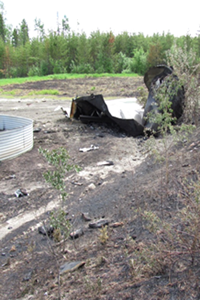Storage tank exploded at sour gas well site
Date of incident: June 2015
Notice of incident number: 2015175160011
Employer: Oil or gas production company
Incident summary
A sour gas well site was being shut down for maintenance. (Sour gas contains significant amounts of hydrogen sulphide.) Workers removed the pressure safety valves (PSVs) and then left the site. About two and a half hours later, a storage tank at the well site exploded. No workers were at the site.
Investigation conclusions
Cause
- Conditions known to result in explosions existed: All the factors that contributed to or caused the explosion cannot be definitively determined. What can be extrapolated from the analysis of the samples is that iron sulphides were present in the storage tank and within some of the piping from an adjacent well site. The explosion itself indicates there was sufficient oxygen in the tank to support a fuel‑air explosion. The most probable cause of the explosion was the ignition of the iron sulphide deposits above the storage compartment housing the heater. The heat resulting from the exothermic reaction of the iron sulphides ignited the fuel‑air mixture within the tank. The vent pipe to the flare and thief hatch could not compensate for the rapidly expanding gases, which were confined to the inside volume of the storage tank until the tank welding failed catastrophically, resulting in an explosion and the expulsion of material and burning hydrocarbons throughout the debris area.
Underlying factors
- Open system: When the third PSV was removed from the flare knockout tank, it was discovered that there were no bull plugs or caps to seal the system. These had to be recovered back at the processing plant. It is estimated that up to about 50 minutes elapsed before the system was sealed. This last PSV was the only PSV in a direct path to the storage tank; when it was removed, the 0.06 psi pressure of blanket (fuel) gas was vented faster than it would usually be vented through the flare stack. The fuel gas was shut in at the storage tank as part of the work process. Air was able to flow into the storage tank once the positive pressure of the isolated fuel gas was insufficient to prevent air to enter. At some point prior to the explosion, the fuel‑to‑air ratio was within the explosive threshold. The employer’s investigation report concluded that the integrity of the thief hatch was compromised prior to the explosion, such that it may have admitted warm, dry air into the tank, promoting the formation of the iron sulphide. If this was the case, the use of blanket gas (sweet gas) was effectively maintaining a low oxygen‑fuel mixture, inhibiting a reaction from the iron sulphide formation.
- Insufficient training and instruction: The employer’s system of training and instruction to the contractors did not enable the workers to recognize a potential hazard and adhere to industry recommended practices and corporate procedures. One operator was at the time not validated in being able to discuss hazards and safe operating procedures when dealing with iron sulphides or iron oxide scale. The other operator was validated; however, he did not consider the warm or hot piping at one of the nearby sour gas well sites to be a concern and did not report the reaction in the piping from that well site to the area foreman or management.
- No prior iron sulphide conditions at the site: Prior to the incident, there were no indications of iron sulphide deposits forming in the operations site. However, iron sulphides are a common occurrence at sour gas facilities and are known as a potential industry hazard for fire and explosions.
2021-04-22 20:42:33

